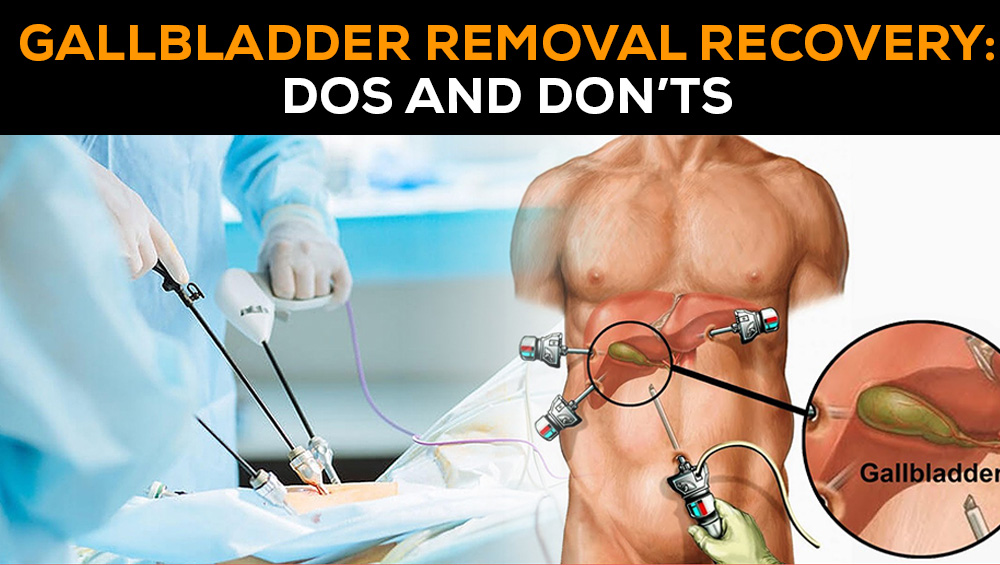Gallbladder removal recovery is the most important steps following the cholecystectomy. Utilizing modern techniques like robotic surgery and laparoscopic surgery the procedure is completely secure as well as minimally invasive.
It is not just about getting better quickly but also staying free of issues and adapting to the changes in digestion. In this blog, we'll give you an overview of the recovery timelines, changes to digestion, the best practices and avoidance lifestyle tips, as well as answers to your questions so that you can recover in a safe manner.
How Long Is the Recovery Time?
Recovery from gallbladder surgery will be different depending upon your age, overall condition and the type of surgery performed.
- First Few Days: Pain, swelling and discomfort around the incision site are common. You may also feel tired easily.
- First Week: Gradual return to light activities is possible. Many people can resume desk work within a week depending on the nature of their job and the pace of their gallbladder removal recovery.
- Weeks 2–4: Most discomfort subsides during this period. Energy levels improve but hard activities and heavy lifting should still be avoided.
- Weeks 4–6: By this stage patients usually feel almost normal and can resume regular activities including exercise but always follow your doctor’s advice.
People begin to notice consistent improvement in energy, digestion and general well-being within a few weeks of gallbladder removal recovery.
What Digestive Changes Can Occur?
The gallbladder’s main role is to store bile which helps digest fats. After removal, bile flows directly into the intestine. This small change in digestion may cause temporary symptoms during the gallbladder surgery recovery period:
- Gas and Bloating – You become more gassy or bloated, particularly after eating.
- Loose stool - Some people experiance diarrhea or frequent colon movements.
- Difficulty with Fatty Foods – Fried foods or oily foods tend to result in indigestion or stomach discomfort.
- Mild Acidity – Since bile is always flowing, stools become looser and occasionally the stomach is somewhat more acidic.
- Food Sensitivity – Some foods such as dairy, hot or extremely fatty foods may not be suitable for you initially.
Dos After Gallbladder Removal
Here are some important dos to promote healing after gallbladder removal:
- Prioritize Rest: Get enough rest in the first days after surgery to allow your body to heal.
- Start activity slowly: slowly increase physical activity as per your body strength. Walking is the best way to promote recovery and prevent blood clots.
- Maintain a Healthy Diet: Make sure you eat a balanced diet that is low in levels of fat as well as rich in fruits, vegetables and whole wheat.The body adapts to the continuous circulation of Bile.
- Take smaller meals but frequent meals: Instead of three big meals consider eating five to six smaller meals throughout the day. It reduces the strain on your digestive system.
- Stay Hydrated: Drink plenty of water to stay hydrated and avoid constipation.
- Use the prescribed medication: Follow the prescriptions of your doctor regarding medication for pain or any other prescriptions given by your physician.
Don'ts After Gallbladder Surgery
- Don't lift heavy weights – avoid carrying anything more than 5–7 kg for a minimum of 2 weeks.
- Don't eat heavy, greasy or spicy food right away – They can cause indigestion or diarrhea.
- Don't miss medicines – Use antibiotics and pain medications as directed.
- Don't neglect warning signs – if the stomach is aching, there is constant nausea or swelling around the area of the cut should not be ignored.
- Don't get back to strenuous exercises too early – Allow your body a minimum of 3–4 weeks prior to heavy exercise.
Avoiding these errors will make your gallbladder removal recovery easier and safer.
Lifestyle After Gallbladder Removal
Life without a gallbladder is usually normal. Most patients adapt well, but making small lifestyle changes helps:
- Reduce the intake of fatty food during the initial couple of weeks.
- Take smaller portions over the course of your day.
- Do exercises regularly after healing to keep weight and digestion in check.
Because of Robotic Gallbladder Surgery, patients nowadays often have less hospitalization and a quicker adjustment time which makes the long term lifestyle changes much easier to manage.
Conclusion
Recovery from gallbladder surgery demands patience, time and treatment. By following the guidelines for recovery following gallbladder removal and ensuring a balanced diet and observing your body's indications that you are recovering faster and avoid complications. The majority of people can be back to their routine within a couple of weeks.
Keep in mind that healing is unique for each individual. For the trust treatment contact, Dr. Ajay Yadav, with the experience of 22+ years, is the best Gastrosurgeon in Lucknow. Dr. Ajay Yadav is a highly skilled and dedicated professional who provides the best possible care to his patients.
FAQs on Gallbladder Removal Recovery
1. How long will the healing time be when compared to the men's?
Women generally recover quickly, usually within a couple of weeks following minimally invasive Robotic Gallbladder Surgery.
2. Do I get digestive issues following gallbladder surgery?
Yes, but they're typically temporary. The symptoms of constipation, diarrhea, or difficulty digesting fat-rich food items are common during the initial gallbladder surgery recovery phase.
3. Are Robotic Gallbladder Surgeries better than conventional techniques?
Yes. Robotic Gallbladder Surgery provides greater accuracy, less scarring and faster healing. This results in an easier recovery of the gallbladder.
4. When can I resume work following surgery?
Office employees can resume their work in 7–10 days, whereas laboring jobs can take 2–3 weeks off.
5. Will my life permanently change following gallbladder surgery?
Mostly, no Long-term, individuals live with normal lives. Just be careful of high-fat meals, particularly in the initial months of gallbladder surgery recovery.


